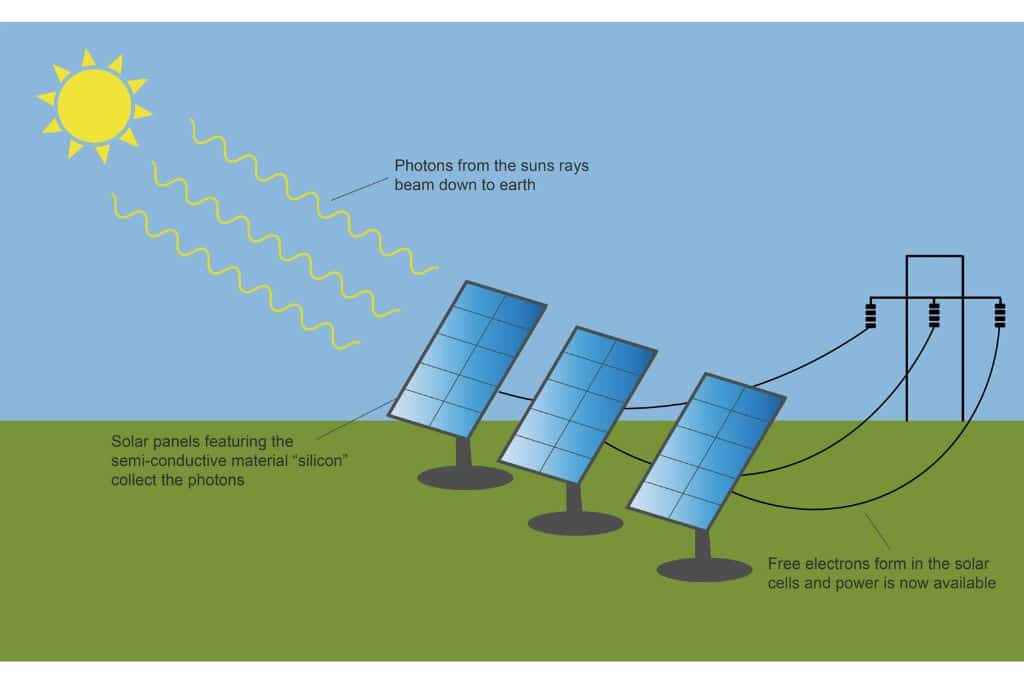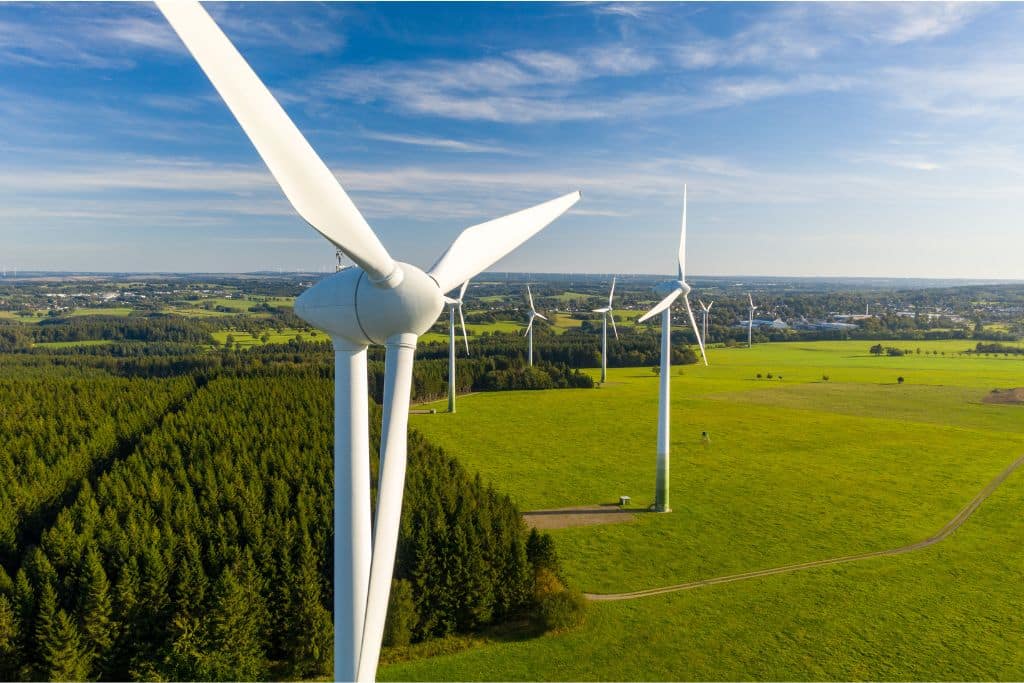While we await data to reveal the overall progress made in 2022 for renewable energy sources, we figured it is worthwhile to get an early analysis of the key headlines in US renewable energies of 2022. The key terminologies associated with renewable energy are environmentally friendly and sustainable. This can include electricity consumption, heating/cooling power, and transportation methods. By 2050, renewable energies are expected to project over 42% of the country’s electricity as compared to 20% today. As of this time, the US renewable energy market is considered the second largest in the world.
—
The United Nations defines renewable energy as energy that replenishes faster than it is consumed. The most common forms include solar, wind, geothermal, hydropower, and bioenergy. The framework of the analysis in this article is based on developments in the US renewable energy market based on these power sources. In 2022, renewables are estimated to constitute 22% of the US electricity generation and experts predict the percentage for 2023 will be even higher. As for total renewable consumption (Industrial, Transportation, Residential, Commercial), renewables accounted for 12.7% as the main sources of those consumptions. Below are the analysis and related statistical developments for each of these main energy power sources in 2022. As we are still early into 2023, many of these statistics will be on a rolling basis as more data starts incoming as we progress further into the year.
As is often the case, macro-economic developments of 2022 (The Federal Reserve’s interest hike mandate targeting inflation, the Russian invasion of Ukraine, China’s zero-Covid policy, etc.) often overshadow another major, contemporary crisis: climate change. Last year was marked by more wildfires in the US and Europe, devastating flooding in Pakistan, as well as massive droughts that impacted major countries around the world, compromising food and water security. Despite the severity of all these issues, major initiatives were established to combat the looming climate threat and set forth a precedent for change. Globally, COP27 in November saw the establishment of a “loss and damage” fund for vulnerable countries. In the US, the Biden Administration passed the inflation Reduction Act, the country’s largest piece of federal legislation to ever address global warming. According to the Congressional Budget Office, the US will invest US$391 billion in provisions relating to energy security and climate change. There will be significant investments in renewables, particularly solar and offshore wind.
There will also be new incentive credits for nuclear power production and clean hydrogen to develop more facilities that produce clean energy inputs and components. This will create the framework for the US to take the necessary steps in its carbon neutrality transition. As the Paris Agreement was set into motion in 2015, countries around the world set a global mandate of keeping the increase in global average temperatures below the 1.5C threshold. There is no doubt that improvements in renewable energy infrastructure within the US, the world’s second-largest polluter behind China, are a key breakthrough that can put the world on the right path. We take a look at the advancements made in the US renewable energy market in 2022 and what is to expect moving forward.
State of the US Renewable Energy Market: A Preliminary Analysis
1. Solar Energy
Of our sun’s energy, only 34% actually reaches the Earth’s surface, with the remaining energy scattered and absorbed by the atmosphere. And of that 34%, only a tiny fraction is captured and used efficiently. Humans worldwide use approximately 13 terawatts of energy each day, which is only a small fraction of the total global energy output from the sun. Humans use approximately 0.01% of the sun’s total energy each day. The total amount of energy reaching the Earth’s surface from the sun daily is 173,000TW. This is more than 10,000 times the world’s total energy use. The amount of energy that we use daily is much less than the amount of energy produced by the sun, but it is still a considerable amount. On a global scale, solar energy is currently the fastest-growing form of renewable energy and is only expected to keep expanding. Common forms of solar energy include photovoltaic (PV panels), which are used to generate electricity, as well as solar thermal systems, which use heat from the sun to produce hot water and steam.

Image 1: How solar panels work
Despite the developing infrastructure and policy incentives in utilising solar energy, it only accounts for 2.8% of total US energy consumption. This figure is expected to increase as technological developments decrease solar costs and better infrastructural designs are set to facilitate solar energy. The rapid growth has contributed to a decrease in the cost of solar generation. The cost of photovoltaic electricity in 2020 was around $0.06 per kilowatt-hour, a decrease of more than 85% since 2010.
Currently, the states with the most effective solar policies are California, New Jersey, New York, Hawaii, and Arizona, which offer various incentives and subsidies for residential and commercial installations, including net metering and tax credits. In 2020, Hawaii had more than 19.6% of its total energy consumption coming from solar. California comes in second with an estimated 7.1%.
You might also like: What Are the Advantages and Disadvantages of Solar Energy?
2. Wind Energy
Common forms of wind energy are onshore (on land) and offshore (at sea) wind farms. The top five companies in the US for wind energy capacity are NextEra Energy, Invenergy LLC, EDP Renewables, Duke Energy, and Berkshire Hathaway Energy. Currently, wind energy accounts for 9.2% of total US renewable energy consumption, making it the largest source of renewable energy in the country behind hydropower. In the US, Texas uses the most wind energy, generating over 92TWh of electricity in a year, and more than the next three top states (Iowa, Oklahoma, and Kansas) combined. The abundance of open land in those midwestern states ensures the steady flow of wind power.
Today, nearly 70,000 wind turbines across the country generate clean, reliable power. Wind power capacity totals nearly 140 GW, making it one of the largest sources of electricity generations in the country. This is enough wind power to serve the equivalent of 43 million American homes.

Image 2: Four types of wind energy
You might also like: 4 Indisputable Advantages of Wind Energy
3. Geothermal
Geothermal energy, a form of energy derived from the heat of the Earth’s core, is the most used type of renewable energy in the US for heating and cooling. Similar to solar and wind power, geothermal energy can also be used to generate electricity. The market size of geothermal energy in the US is relatively small compared to other renewable energy sources such as solar and wind power. However, it is still significant, with an estimated installed capacity of around 3.86 GW in 2021. Geothermal is expected to account for about 0.4% of total US renewable energy generation in 2022. The geothermal energy market in the US is valued at several billion dollars annually. In 2020, the total annual revenue of the US geothermal energy industry was around $2.7 billion. Worldwide, International Renewable Energy Agency (IRENA) forecasts that geothermal power generation will increase from 78GW in 2019 to 103 gigawatts in 2022. The US, Philippines, Indonesia, and Mexico utilize the most in geothermal power generation and thus the largest consumers. Cumulatively, these countries represent about 75% of global geothermal power generation. The most efficient uses of geothermal energy technologies are direct-use systems, ground source heat pumps (GSHPs), and enhanced geothermal systems (ESG). For GSHPs, a loop of tubing is placed underground to capture the Earth’s natural heat. EGS involves drilling deep wells to access hot rocks which can generate electricity.
Currently, the states with the largest geothermal energy capacity annually are:
- California (1,927 MW)
- Nevada (1,377 MW),
- Utah (940 MW),
- Oregon (447 MW),
- Idaho (395 MW).
Together, these five states accounted for 83% of the total installed geothermal energy capacity in the US for 2021/2022.
You might also like: The Main Advantages and Disadvantages of Geothermal Energy
4. Hydropower
Hydroelectric power, or hydropower, is one of the oldest sources of renewable energy. In this case, the natural flow of moving water is used to generate electricity, water supply, and irrigation. Hydropower currently accounts for about 6.3% of total US electricity generation, making it the second largest source of renewable energy in the US. It was only around 2020 that wind energy surpassed hydropower to be the largest source of US electricity generation. The three largest hydropower companies in the US are PacifiCorp, Xcel Energy, and Dominion Energy.
Common forms of hydropower are traditional large-scale hydroelectric dams and smaller-scale “run-of-river” projects. Large-scale hydro-projects use impoundment dams to store water and generate electricity on demand, while run-of-river projects take advantage of naturally occurring flows of rivers and streams as they pass through a dam to generate power.
Future hydropower developments in the US include more investment in both large and small-scale projects seeking to make more efficient use of existing infrastructure and water resources and the exploration of alternative techniques such as pumped storage and water-to-wire technologies. Additionally, the US Bureau of Reclamation is working to develop new hydropower projects at existing dams, which could add an additional 10GW of capacity to the nation’s energy grid by 2030.
The main advantage of hydropower over other forms of renewable energy like wind and solar is that this type of renewable energy is the least reliant on seasons or weather. It also benefits from greater efficiency, as the ability to store water is a form of technology that society has already perfected. Weaknesses, however, include that hydropower is more difficult to build and thus has a major reliance on costly infrastructure investments. Better technology and considerate reservoir management practices that mitigate effects on downstream ecosystems are key developments that will help hydropower expand as a renewable energy use.

Image 3: The Grand Coulee Dam has a capacity of 6,809 megawatts (MW) and generates an average of 21 billion kilowatt-hours (kWh) of electricity per year, enough to power over 2 million households (Image by Ted McGrath/Flickr)
5. Biomass
Biomass, renewable organic material that comes from plants and animals, was the largest source of total annual energy consumption in the US until the mid-1800s. Today, it only accounts for around 5.4% of the total energy produced in the country. Bioenergy includes electricity and heat generated from biomass, biogas, and liquid biofuels. The residential, commercial, and industrial sectors make up nearly 60% of total bioenergy consumption. The agricultural sector is also a major consumer of bioenergy in the country. Future developments include the introduction of more efficient technologies and processes, the expansion of existing resources, and the development of new sources of biomass, biogas, and liquid biofuels.
Image 5: The 6 types of biomass energy
US Renewable Energy Market: What’s Next?
Today, fossil fuels (coal, natural gas, petroleum, etc.) still account for nearly 81% of total US energy consumption, while the remaining energy outputs are through renewables. Yet, positive initiatives and supporting policies on an international scale have contributed to speeding up the development of renewable energy, which is now on track to overtake coal and become the largest source of global electricity in perhaps 3 years’ time. For reference, renewables generated 19.5% of the US’s net electricity production, while coal plants generated 19.3% and nuclear plants 19.7%. Electricity net generation refers to the “amount of gross electricity generation a generator produces minus the electricity used to operate the power plant”. Renewables are not as far off as many people would believe, and clearly has the potential to be more efficient. The US generates more renewable electricity than Germany, Japan, and the UK combined. Thus, the US plays an important role in the global initiative to gradually transition out of fossil fuels.
According to early estimates, the global market size of renewable energies is expected to reach two trillion USD by 2030. The US renewable energy market in 2022 was valued at US$269 billion. The International Energy Agency (IEA) also expects renewables to become the largest source of global electricity by 2025. With US revenues from fossil fuels responsible for $138 billion annually, the amount is expected to fall given the infrastructure and cost improvements in renewable energy as well as further government policies to decrease the reliance on fossil fuels. For electricity generation, solar and wind are the fastest and most popular methods Supporting renewable energy initiatives in local jurisdictions and implanting them within our lives if it is cheaper and more practical to do so are all actions we can control as individuals. Technology will continue to cut the costs of renewable energy infrastructures, and this decade is showing a lot of promise for this continued growth trajectory.
You might also like: Renewables on Track to Become Largest Source of Global Electricity by 2025, IEA Says

















